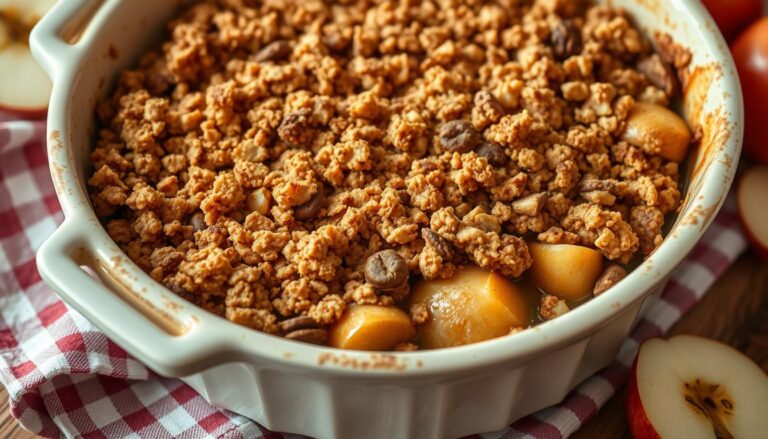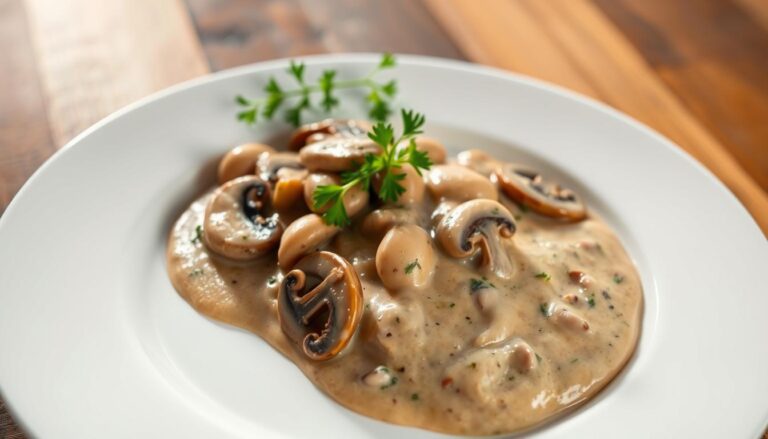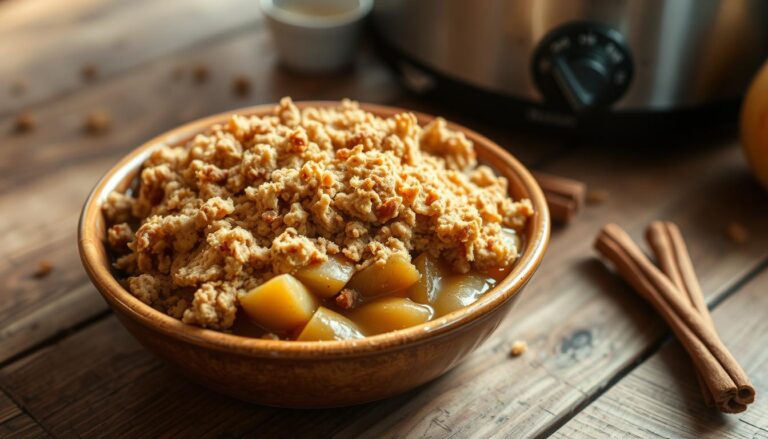Easy Pot Roast Recipe: Tender, Flavorful Meal
There’s nothing like a warm, comforting meal to bring the family together. A tender pot roast is the epitome of comfort food, and with this easy recipe, you can achieve a flavorful dish that’s sure to become a staple in your household.
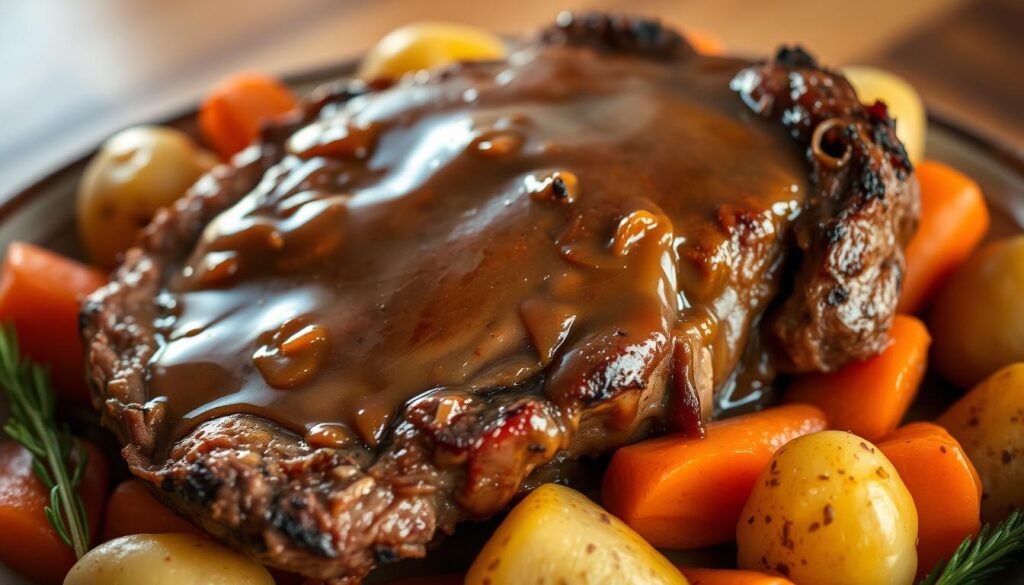
This pot roast recipe is designed to be straightforward and simple, requiring minimal preparation and effort. The result is a deliciously tender and flavorful meal that’s perfect for any occasion.
Key Takeaways
- A simple and easy-to-follow recipe for a delicious pot roast.
- Tender and flavorful results with minimal preparation.
- Perfect for family gatherings or a comforting meal.
- Minimal effort required for a satisfying outcome.
- A great recipe for those looking for a traditional comfort food dish.
What Makes a Perfect Pot Roast
The art of cooking a perfect pot roast lies in understanding the science behind it. A perfect pot roast is characterized by tender meat and rich, developed flavors, both of which are achieved through the slow cooking process.
The Science Behind Tender Meat
Tender meat in a pot roast is achieved by breaking down the connective tissues through slow cooking. This process involves cooking the meat at a low temperature for an extended period, allowing collagen to convert into gelatin, thus tenderizing the meat. Slow cooking methods, such as braising, are ideal for tougher cuts of meat, making them tender and palatable.
Flavor Development in Slow Cooking
Flavor development is another critical aspect of a perfect pot roast. The slow cooking process allows the flavors from the meat, vegetables, and seasonings to meld together, creating a rich and savory dish. The use of aromatic vegetables and herbs enhances the flavor profile, making the pot roast more delicious.
| Cooking Method | Tenderizing Effect | Flavor Development |
|---|---|---|
| Slow Cooking | High | Excellent |
| Grilling | Low | Good |
| Braising | High | Excellent |
Essential Ingredients for a Classic Pot Roast Recipe
To make a classic pot roast, you’ll need a few staple ingredients that work together in harmony. The right combination of beef, vegetables, and seasonings is crucial for achieving that tender, fall-apart texture and rich flavor that pot roast is known for.
Choosing the Right Cut of Beef
The foundation of a great pot roast is the cut of beef. Opt for a tougher cut that’s rich in connective tissue, such as a chuck roast or round roast. These cuts are perfect for slow cooking, as they become tender and flavorful with time. When selecting a beef cut, look for one with a good balance of fat and lean meat, as this will enhance the overall flavor and texture.
Vegetables That Complement Pot Roast
Vegetables play a crucial role in pot roast, adding depth and complexity to the dish. Classic choices include carrots, potatoes, and onions. These vegetables not only complement the beef but also absorb the rich flavors of the cooking liquid. Consider adding other vegetables like celery or parsnips to create a hearty and satisfying meal.
Herbs and Seasonings for Maximum Flavor
The right herbs and seasonings can elevate your pot roast from good to great. A blend of thyme, rosemary, and bay leaves provides a classic flavor profile, while a mix of garlic and paprika adds depth. Don’t forget to season generously with salt and pepper to bring out the natural flavors of the ingredients.
By focusing on these essential ingredients, you’ll be well on your way to creating a delicious, comforting pot roast that will become a family favorite.
Kitchen Equipment You’ll Need
To achieve a tender and flavorful pot roast, selecting the appropriate kitchen tools is essential. The right equipment can make a significant difference in the cooking process, ensuring that your pot roast turns out perfectly cooked.
Dutch Oven vs. Slow Cooker vs. Instant Pot
When it comes to cooking a pot roast, three popular options are often considered: Dutch ovens, slow cookers, and Instant Pots. Each has its unique benefits:
- Dutch Oven: Ideal for slow cooking and braising, Dutch ovens distribute heat evenly, resulting in tender meat.
- Slow Cooker: Perfect for a “set-it-and-forget-it” approach, slow cookers are great for cooking pot roast over a long period.
- Instant Pot: For those short on time, Instant Pots can significantly reduce cooking time while still achieving tender results.
Other Helpful Tools
In addition to the primary cooking vessel, other tools can enhance your pot roast cooking experience. These include:
- Sharp knives for trimming meat and chopping vegetables.
- Heavy-duty tongs for handling the roast.
- A meat thermometer to ensure the perfect doneness.
By choosing the right equipment and tools, you can simplify the cooking process and achieve a delicious pot roast.
Preparing Your Ingredients
To achieve a tender and flavorful pot roast, start by preparing your ingredients with care. Proper ingredient preparation is crucial for the overall success of the dish.
The process involves more than just gathering the necessary items; it requires attention to detail in preparing each component. This ensures that every element of the pot roast contributes to its overall flavor and texture.
Meat Preparation Techniques
Preparing the meat for pot roast involves several key steps. First, trim any excess fat from the surface of the roast, leaving a thin layer to enhance flavor. Next, season the meat generously with salt, pepper, and your choice of herbs. For a more intense flavor, consider searing the meat before slow cooking.
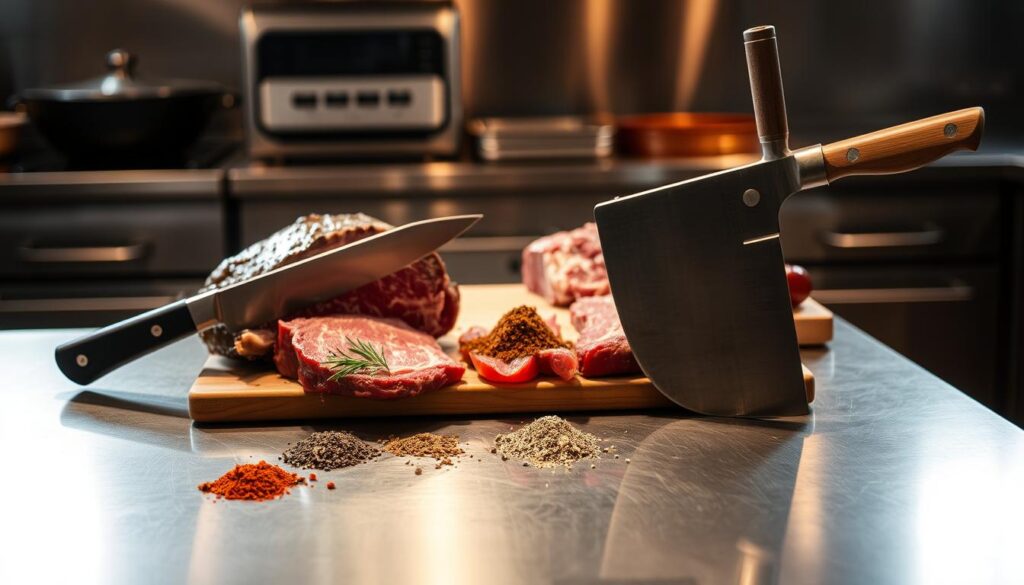
Additionally, some recipes may call for marinating the meat beforehand. While not necessary, marinating can add depth to the dish. Use a mixture of olive oil, garlic, and herbs to create a flavorful marinade.
Vegetable Cutting Guide
Cutting vegetables appropriately is vital for even cooking and a harmonious texture in the finished dish. Start by selecting fresh, firm vegetables that complement the pot roast. Carrots, potatoes, and onions are classic choices.
For uniform cooking, cut the vegetables into similar-sized pieces. This ensures that they cook at the same rate, preventing some from becoming too soft while others remain hard. For root vegetables like carrots and potatoes, cutting them into 2-inch chunks is a good rule of thumb.
The Ultimate Pot Roast Recipe: Step-by-Step Instructions
Mastering the pot roast cooking technique is all about understanding the importance of each step in the process. To achieve a tender and flavorful meal, it’s crucial to follow a well-structured approach.
Searing the Meat Properly
The first step in cooking the perfect pot roast is searing the meat. This process involves browning the surface of the roast on all sides using high heat. Searing enhances the flavor and texture of the meat. To sear properly, heat a couple of tablespoons of oil in a large Dutch oven over medium-high heat. Season the pot roast with salt and pepper before placing it in the hot oil. Brown the roast on all sides until it develops a rich, golden-brown crust.
Building the Flavor Base
After searing the meat, the next step is to build the flavor base. This involves sautéing aromatic vegetables such as onions, carrots, and celery in the same pot used for searing the meat. These vegetables are sautéed until they are softened and lightly browned, which adds depth to the dish. You can also add garlic and other aromatics to enhance the flavor further.
“The key to a rich and flavorful pot roast lies in the quality of the ingredients and the patience to let it cook slowly.”
Chef’s Wisdom
Liquid Additions and Braising
Braising liquid is a critical component of pot roast cooking. After sautéing the aromatics, add a suitable braising liquid to the pot. This can include beef broth, red wine, or a combination of both. The liquid should cover about two-thirds of the pot roast. Bring the liquid to a simmer, then cover the pot and transfer it to a preheated oven or continue cooking it on the stovetop on low heat.
| Braising Liquid Options | Description |
|---|---|
| Beef Broth | Provides a rich, meaty flavor |
| Red Wine | Adds a deep, slightly acidic flavor |
| Combination | Balances flavors for a complex taste |
Testing for Perfect Doneness
The final step is testing the pot roast for doneness. The meat is perfectly cooked when it is tender and easily shreds with a fork. Check the roast periodically during the cooking time, as the cooking duration can vary based on the size and type of the roast. Once the meat is tender, remove it from the heat and let it rest before serving.
By following these step-by-step instructions, you’ll be able to achieve a deliciously tender and flavorful pot roast that’s sure to impress. Whether you’re a novice cook or an experienced chef, these pot roast cooking tips will help you master the art of braising.
Slow Cooker Pot Roast Method
The slow cooker method for pot roast offers a ‘set-it-and-forget-it’ approach that’s perfect for busy days. This cooking technique allows for a tender, flavorful meal with minimal supervision, making it an ideal choice for those who want to come home to a ready-to-eat dinner.
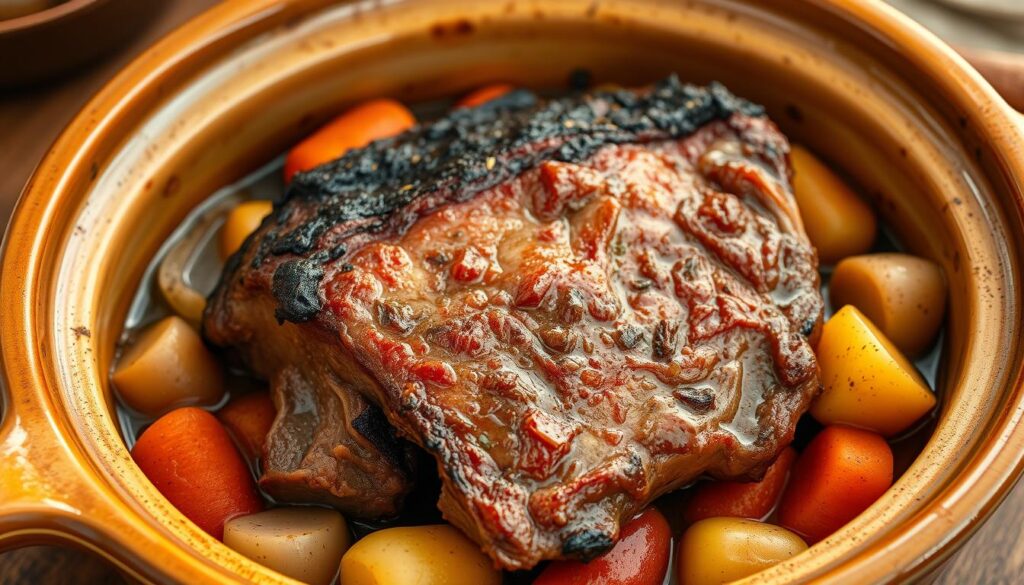
Adapting the Recipe for Slow Cookers
To adapt the pot roast recipe for a slow cooker, start by searing the meat and sautéing the vegetables as instructed in the original recipe. Then, transfer everything to the slow cooker. Use the following guidelines:
- Add the seared meat and sautéed vegetables to the slow cooker.
- Include the necessary liquids and seasonings as per the original recipe.
- Cook on low for 8-10 hours or on high for 4-6 hours.
This method ensures that the pot roast is tender and the flavors are well-developed.
Set-It-and-Forget-It Tips
To maximize the ‘set-it-and-forget-it’ benefit of your slow cooker pot roast, consider these tips:
- Don’t Overfill: Ensure the slow cooker is not more than 3/4 full to allow for even cooking.
- Layer Ingredients Wisely: Place tougher vegetables like carrots at the bottom where it’s hotter.
- Minimize Lid Lifting: Resist the temptation to check on the pot roast too frequently, as this can increase cooking time.
By following these tips, you’ll achieve a delicious, comforting meal with minimal effort, embodying the convenience of slow cooker pot roast.
Instant Pot Pot Roast Variation
Instant Pot pot roast is a game-changer for home cooks seeking tender, flavorful results in significantly less time. The Instant Pot’s pressure cooking capability allows for a dramatic reduction in cooking time without sacrificing the rich flavors and tender texture that pot roast is known for. This method is particularly appealing to those with busy schedules who still want to enjoy a home-cooked meal.
Pressure Cooking Benefits for Pot Roast
Pressure cooking with an Instant Pot offers several benefits when it comes to cooking pot roast. The primary advantage is the significant reduction in cooking time. What typically takes several hours in a slow cooker or Dutch oven can be achieved in under an hour with an Instant Pot. This is because the pressure cooker works by sealing in steam, which increases the pressure inside the pot and allows the meat to cook more quickly.
Another benefit is the retention of flavors and nutrients. The sealed environment of the Instant Pot ensures that the flavors are locked in, resulting in a more intense and satisfying taste experience. As noted by culinary experts, “Pressure cooking is an excellent way to cook pot roast as it preserves the moisture and flavor of the meat.”
Quick Pot Roast Timeline
Cooking pot roast in an Instant Pot is not only about saving time but also about achieving consistent results. Here’s a basic timeline for cooking pot roast in an Instant Pot:
- Searing the meat: 5 minutes
- Pressure cooking: 30-40 minutes, depending on the size and cut of the meat
- Natural pressure release: 10-15 minutes
This timeline can vary based on personal preference for the tenderness of the meat and the specific model of the Instant Pot. However, it provides a general guideline for achieving a delicious pot roast in a fraction of the time required by traditional methods.
Troubleshooting Common Pot Roast Problems
Even with the best recipes, pot roast can sometimes go wrong, but don’t worry, we’ve got you covered. Whether you’re dealing with tough meat, gravy that’s too thin or too thick, or flavors that need balancing, these troubleshooting tips will help you achieve a delicious pot roast.
Fixing Tough Meat Issues
Tough meat is often a result of inadequate cooking time or incorrect cooking temperatures. To avoid this, ensure your pot roast is cooked at a low temperature for a sufficient amount of time. Using a meat thermometer can help verify that the internal temperature reaches a tender 190°F to 195°F. If your meat is already cooked but still tough, consider shredding it and continuing to simmer it in the gravy to further tenderize it.
Adjusting Thin or Thick Gravy
The consistency of your gravy can make or break your pot roast dish. If your gravy is too thin, you can thicken it by mixing a tablespoon of cornstarch or flour with a little water or broth before stirring it into the gravy and simmering until it thickens. Conversely, if the gravy is too thick, you can thin it out with a bit of broth or water, adding it gradually until you achieve the desired consistency.
Balancing Flavors Last-Minute
If your pot roast tastes bland or unbalanced, there are several last-minute adjustments you can make. Consider adding a splash of vinegar or a squeeze of fresh lemon juice to brighten the flavors. Alternatively, a sprinkle of fresh or dried herbs can add depth and warmth. For a richer flavor, you can also stir in a bit of mustard or a spoonful of tomato paste.
- Add a splash of vinegar or lemon juice for brightness.
- Sprinkle fresh or dried herbs for added depth.
- Stir in mustard or tomato paste for a richer flavor.
By applying these troubleshooting tips, you can rescue your pot roast from common pitfalls and ensure a delicious, satisfying meal.
Serving Suggestions for Your Pot Roast
The art of serving pot roast lies in the details of its accompaniments and presentation. A well-cooked pot roast is the centerpiece of a comforting meal, and the right sides and presentation can elevate it to a memorable dining experience.
Classic Side Dishes
When it comes to side dishes for pot roast, traditional options never go out of style. Mashed potatoes, roasted vegetables, and fresh green salads are timeless choices that complement the rich flavors of pot roast.
- Mashed Potatoes: A classic comfort food that pairs perfectly with the tender, fall-apart texture of pot roast.
- Roasted Vegetables: Carrots, Brussels sprouts, and parsnips roasted to perfection bring a delightful contrast in texture and flavor.
- Fresh Green Salad: A simple salad with mixed greens, cherry tomatoes, and a light vinaigrette provides a refreshing contrast to the hearty pot roast.
| Side Dish | Description | Preparation Time |
|---|---|---|
| Mashed Potatoes | Boiled potatoes mashed with butter and milk | 20 minutes |
| Roasted Vegetables | Vegetables tossed with olive oil and roasted in the oven | 30 minutes |
| Fresh Green Salad | Mixed greens with cherry tomatoes and light vinaigrette | 10 minutes |
Presentation Tips for Impressive Meals
Presentation is key when serving pot roast. A beautifully presented dish can make a significant difference in the overall dining experience. Consider slicing the pot roast against the grain and arranging it on a platter with your chosen side dishes.
To add a touch of elegance, garnish with fresh herbs like thyme or rosemary. The visual appeal of your meal can be further enhanced by using colorful plates and adding a sprinkle of fresh parsley around the dish.
Creative Leftover Ideas
Give your leftovers a second life with these innovative ideas. Pot roast, being a versatile dish, can be repurposed in numerous delicious ways, reducing food waste and saving you time in the kitchen.
Pot Roast Sandwiches and Tacos
Transform your leftover pot roast into mouth-watering sandwiches or tacos. Simply shred or chop the pot roast and season it with your favorite spices. Serve it on a crusty bun or in a taco shell, topped with your choice of condiments and sides. Pot roast sandwiches are a classic comfort food, while tacos offer a fun twist.
Transforming Leftovers into New Meals
Beyond sandwiches and tacos, you can create entirely new meals. Use leftover pot roast to make a hearty beef stew or add it to a salad for a protein-packed meal. You can also use it as a filling for baked potatoes or as a topping for a savory pie.
| Leftover Idea | Description |
|---|---|
| Pot Roast Sandwiches | Shredded or chopped pot roast served on a bun |
| Pot Roast Tacos | Seasoned pot roast in taco shells |
| Beef Stew | Leftover pot roast simmered with vegetables |
Conclusion
Cooking a delicious pot roast is now within your reach. This easy pot roast recipe summary provides a tender, flavorful meal that’s perfect for any occasion. By following the step-by-step instructions and tips outlined in this article, you’ll be able to achieve a mouth-watering pot roast that’s sure to impress.
The pot roast conclusion is clear: with the right ingredients, kitchen equipment, and cooking techniques, you can create a dish that’s both satisfying and delicious. Whether you choose to use a Dutch oven, slow cooker, or Instant Pot, the result is sure to be a tender, fall-apart pot roast that’s full of flavor.
So why not give this pot roast recipe a try? With its ease of preparation and rich, comforting flavors, it’s sure to become a staple in your kitchen. Invite your family and friends to gather around the table and enjoy a warm, satisfying meal that’s sure to leave everyone feeling full and content.
FAQ
What is the best cut of beef for pot roast?
The best cuts for pot roast are typically tougher, fattier cuts like chuck roast or round, which become tender with slow cooking.
Can I cook pot roast in the oven instead of a slow cooker?
Yes, pot roast can be cooked in the oven using a Dutch oven. Simply brown the meat, add your ingredients, cover, and roast at a low temperature (usually around 300°F) for several hours until tender.
How long does it take to cook pot roast in a slow cooker?
Cooking time for pot roast in a slow cooker depends on the size of the roast and the heat setting. Generally, it takes 8-10 hours on low or 4-6 hours on high.
What are some common mistakes to avoid when cooking pot roast?
Common mistakes include not browning the meat before slow cooking, not using enough liquid, and overcooking or undercooking the roast. Using a meat thermometer can help ensure the roast is cooked to a safe internal temperature.
Can I freeze leftover pot roast?
Yes, leftover pot roast can be frozen. Allow it to cool, then store it in an airtight container or freezer bag. It can be safely frozen for up to 3 months. Reheat thoroughly before serving.
How do I achieve tender pot roast?
To achieve tender pot roast, cook it low and slow, either in a slow cooker, oven, or Instant Pot. This breaks down the connective tissues in the meat, making it tender and flavorful.
What are some good side dishes to serve with pot roast?
Classic side dishes that go well with pot roast include mashed potatoes, roasted vegetables (like carrots and Brussels sprouts), and green beans. These complement the rich flavors of the pot roast.
Can I make pot roast in an Instant Pot?
Yes, pot roast can be made in an Instant Pot. Brown the meat using the sauté function, then cook on high pressure for about 60-90 minutes, depending on the size and desired tenderness.
How do I thicken the gravy from pot roast?
To thicken the gravy, you can use a slurry made from equal parts of flour and water, or cornstarch mixed with a little water. Stir the slurry into the hot gravy and simmer until it thickens.



